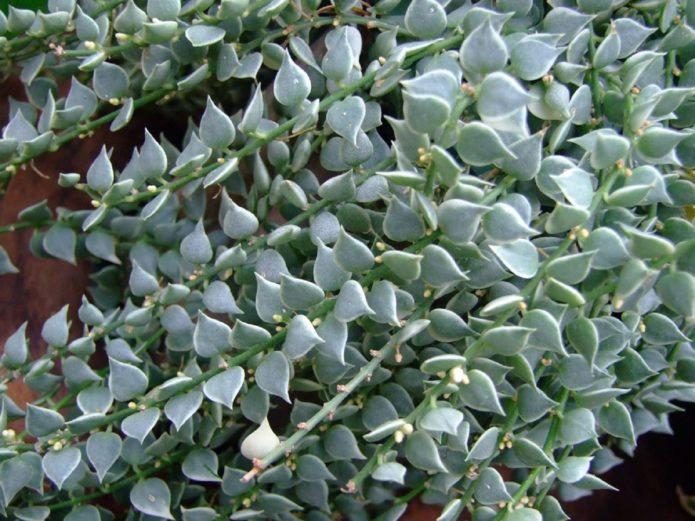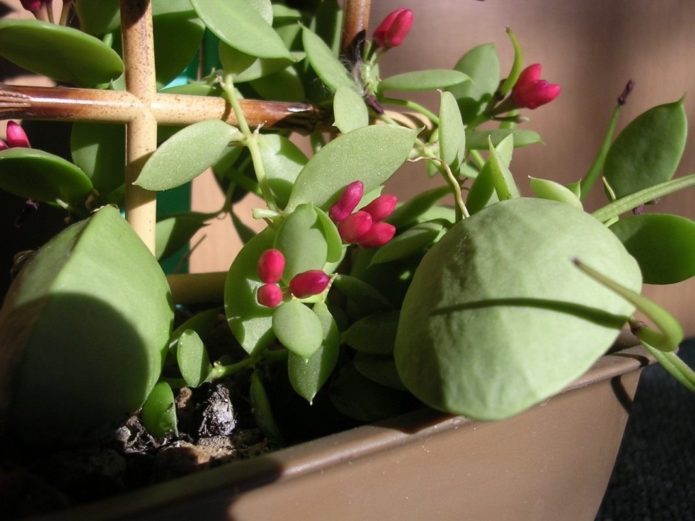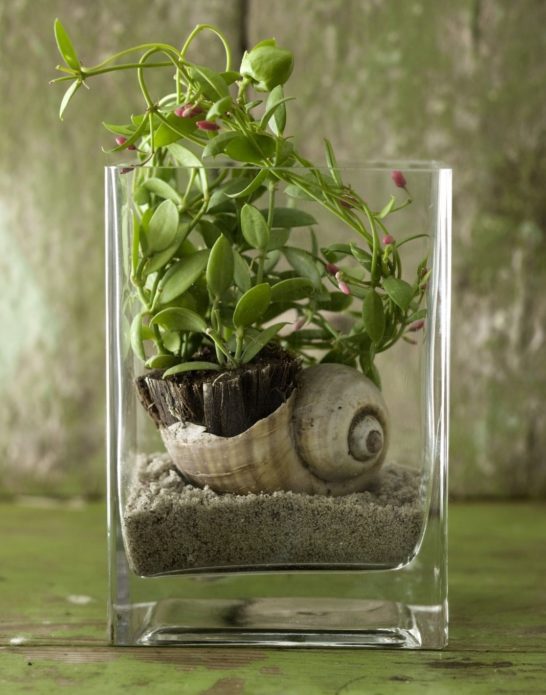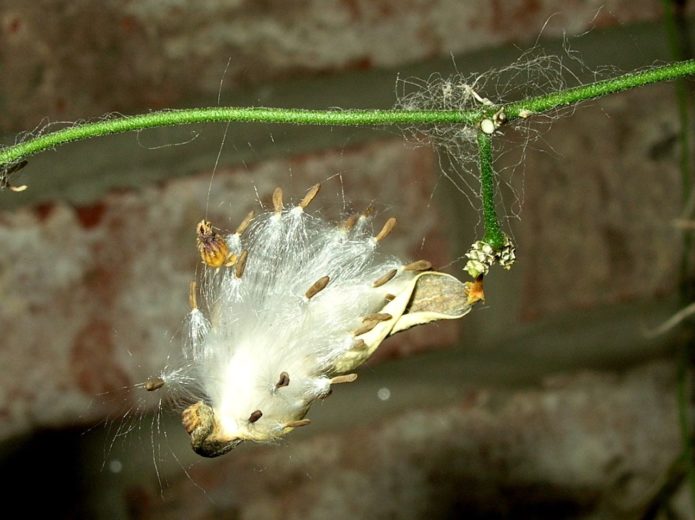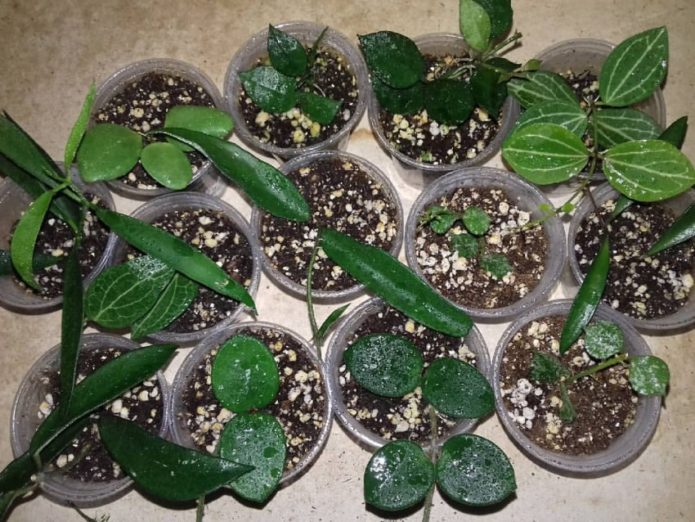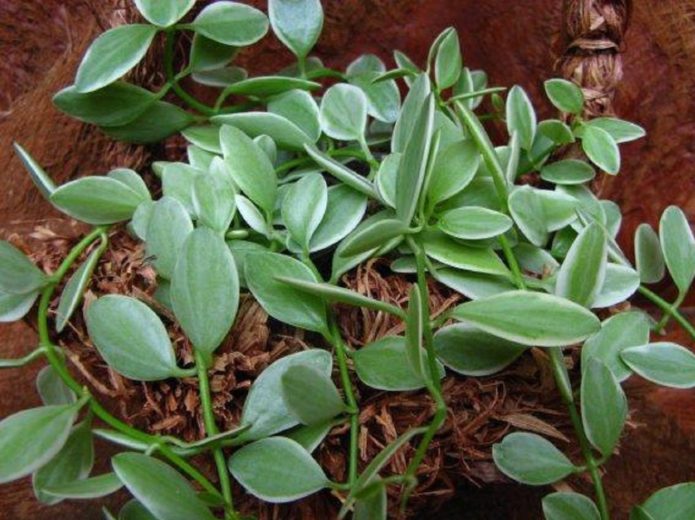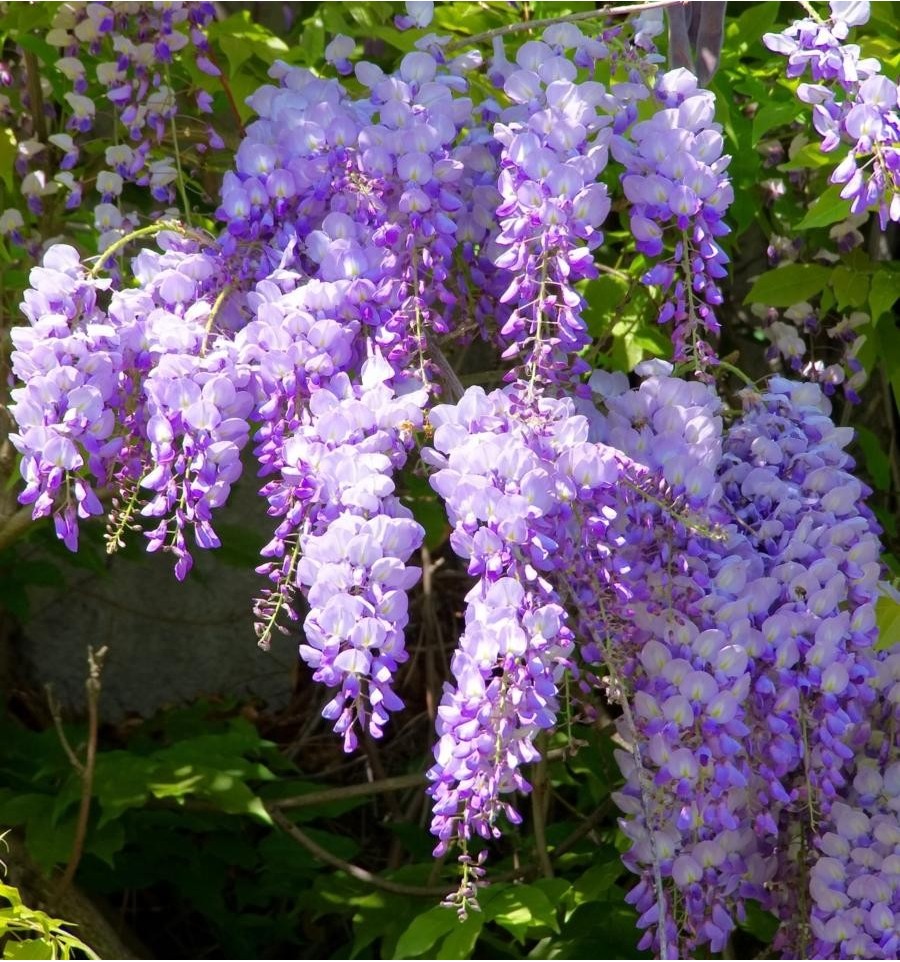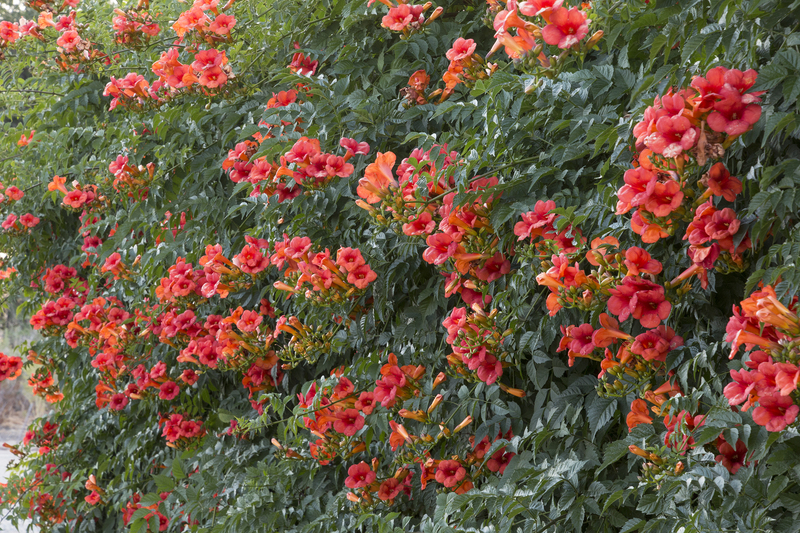Dyschidia refers to the epiphytic representatives of the flora - parasitic plants that attach to other vegetation and exist at the expense of their juices. The flower comes from exotic countries. It can be successfully grown at home with well-organized care, but not all species can be cultivated. This evergreen vine is prized by flower growers for its exquisite and graceful look. Any interior will be transformed with this decor.
Content
What is remarkable about the flower
Dyskhidia is an evergreen liana from the Lastovniev family. The plant is a long (up to 5 meters) flexible green shoots. It has multiple filamentous roots located at the base and partially covering the lower part of the shoots. Due to the well-developed root system, the dyschidia is firmly fixed on the support and draws nutrition from the outside.
Two types of leaves grow on the liana. These are flat rounded leaves on shortened petioles, completely covering the stems. They are usually bright green in color, but other colors are possible, depending on the species. Along with them, there are small leaves up to 5 cm in length, outwardly similar to bubbles. They accumulate moisture, which helps the plant to survive in emergency situations. Often, insects store plant waste there, which gradually rot and serve as fertilizer.
The culture blooms once a year - from spring to autumn... At this time, many small flowers, like bells, are grouped in whorls of several pieces among the leaves. Their color varies, being red, white, pink. Then seed-filled pods appear. Each seed has an umbrella-shaped crown.
It is possible to grow dyschidia indoors as an ampelous plant in hanging pots. Another option is to use decorative vertical supports to which the vine is attached. The result is attractive silhouettes. The only thing is that you cannot plant dyschidia in standard flower pots on the windowsill so that the whips hang down uncontrollably. Deep supports are not suitable either.
Types and varieties with photos
In nature, there are more than 100 species of dyschidia, but a limited number is cultivated. All of them are adapted for indoor breeding, although they need special care.
The most common varieties:
- Ovata is a plant with greenish-pink stems, densely covered with small oval leaves with a white sinewy pattern. Initially, the plates are pink in color, but over time they turn green. Small white buds bloom during flowering. The culture endures a slight cold snap and drafts.
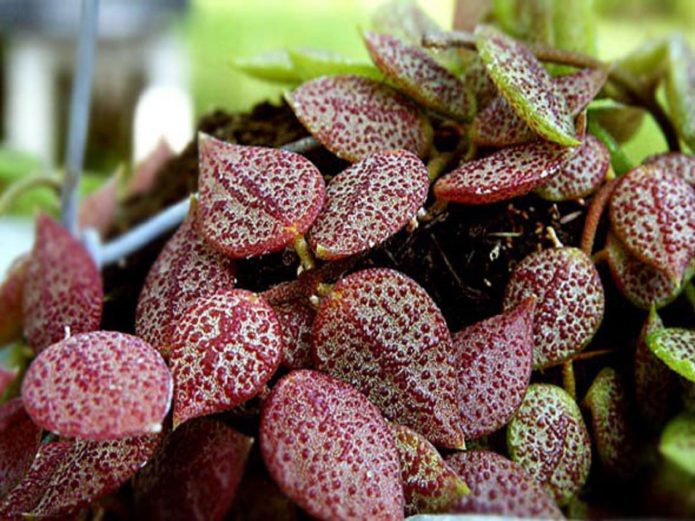
- Pectinoides is a clinging vine with airy root shoots. It has two types of leaves: small - oval and large - bubble-like. On the outside they are green, on the inside - brick color. It blooms with pinkish-purple buds.
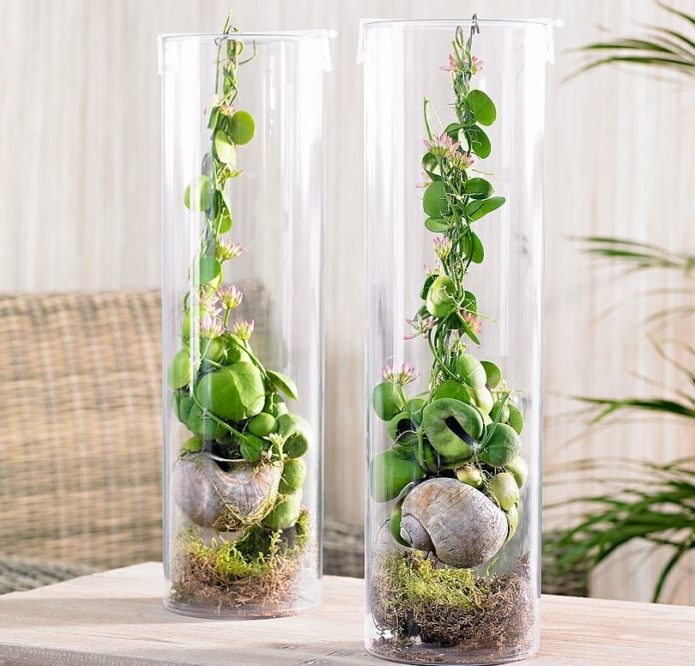
- Singularis is a culture with tough stems and large, rounded green leaves with light streaks.
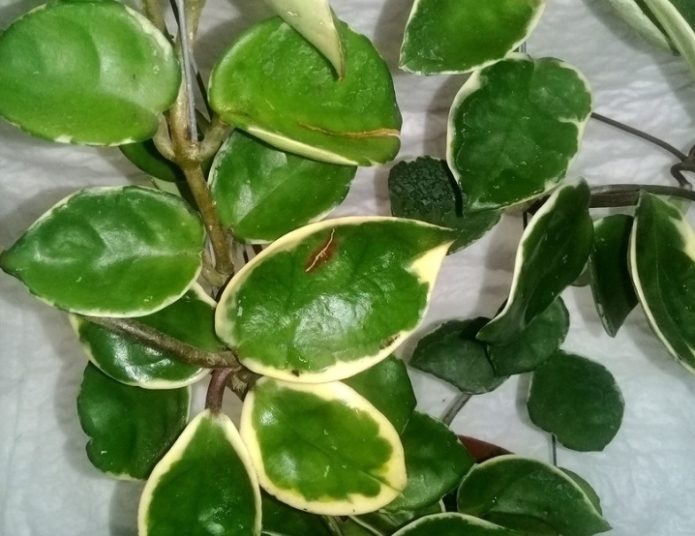
- Ruskusolistnaya - an elegant representative with long shoots, covered with heart-shaped emerald leaves. For this, the flower growers endowed such a dischidia with an intriguing name - "a million hearts"... White flowers form in the leaf axils.During blooming, they exude an amazing honey scent.
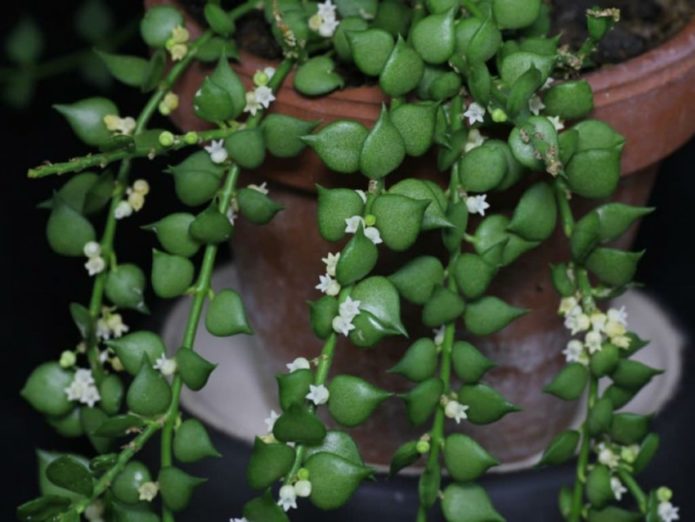
- Scallop is a type of creeping type with stems covered with aerial root processes and elongated leaves. The crown has a deep green color. The plant blooms twice a year with pink or dark cherry flowers.
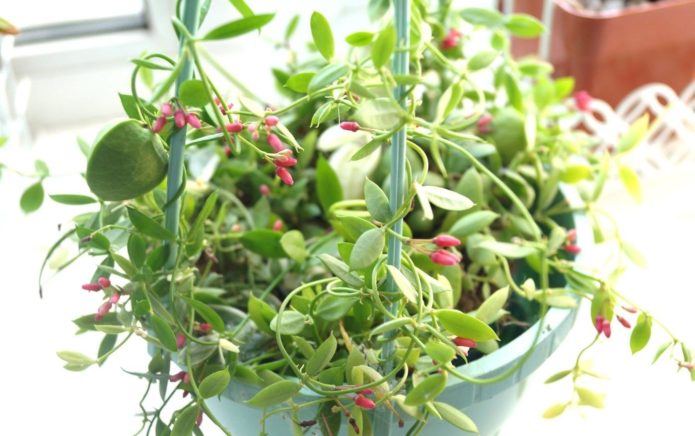
- Hirsuta is a unique species with pubescence on foliage and graceful embossed veins on the outer surface of the plate. The buds are deep scarlet in color, attached to short peduncles. The flowers are small in size, but appear in large numbers and amicably.
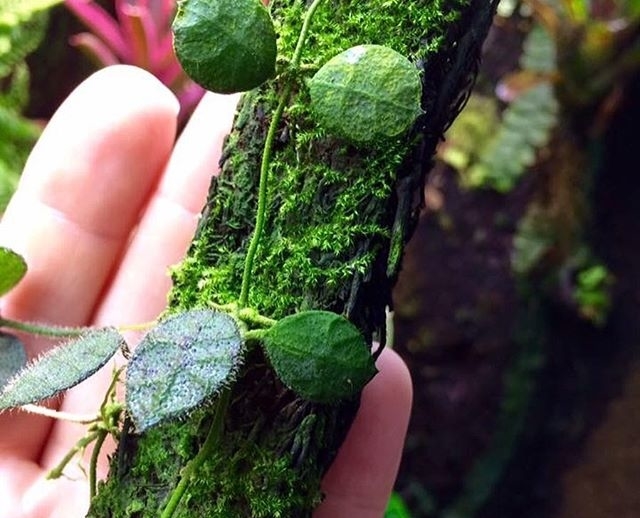
- Raffleza - represents five-meter elastic shoots, densely framed with oval leaves. It blooms with yellow flower baskets, consisting of several small buds.
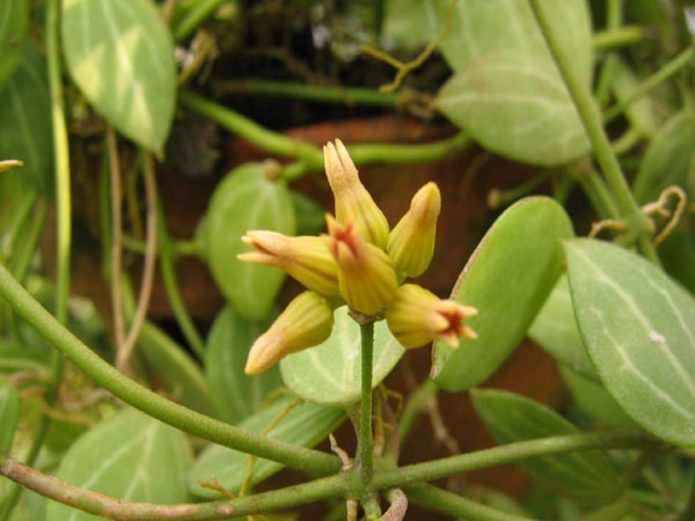
Reproduction methods
Dyschidia can be propagated in two ways: by seeds and cuttings. It is easier and faster to grow a plant from cuttings. However, the second option is no less effective.
Seminal
Dyschidia seeds are extremely light, therefore, when sowing, care must be taken that they do not scatter. Sowing work is usually carried out in the spring.
- A mixture of sand and peat in equal proportions is taken as soil.
- After it has been moistened, seeds are planted and sprinkled with earth on top with a layer of up to 3 mm.
- Cover with plastic wrap or glass.
- Place containers with plantings in a warm and well-lit room, where the temperature does not drop below 20 ° C.
- Crops are moistened and ventilated daily. The first shoots appear in 5–7 days. These sheets are formed after 3 months. Only then are the plants planted in separate pots.
Cuttings
- For this method of reproduction, first cut the cut from the tops of the shoots to a length of 10-15 cm.
- Places of cuts are treated with powdered coal and placed in a solution of any growth stimulant for several hours.
- Cuttings are planted at a slight incline in a wet peat-sand mixture.
- Cover with a glass or plastic cover.
Shoots take root better at 20–25 ° C and high humidity. Every day they need to be watered, opened slightly to ventilate and remove condensate that accumulates inside. After a month, the cuttings take root completely.
Landing
Landing is possible at any time. Dyschidia requires a loose and fibrous substrate. You can cook it yourself by mixing the following ingredients in equal proportions:
- ground pine bark;
- sphagnum moss;
- charcoal;
- river sand;
- leaf compost;
- perlite;
- peat.
It is permissible to purchase a ready-made soil specially designed for orchids or bromeliads.
The culture is transplanted exclusively in the spring, when its root system grows strongly and the volume of the pot becomes small. It is advisable to replant young plants annually, adults - as needed.
First of all, a drainage layer is poured into the bottom of the pot. They capture the roots of the dyschidia together with an earthen clod and carefully transfer them to a new container. This is important, since if the roots are damaged, the plant will not take root in a new place and will die..
The nuances of growing
Dyschidia is a rather capricious representative regarding care, so a novice florist cannot cope with it. The key to successful growing will be stability in terms of the very care and conditions of the plant. The slightest deviations from the norm lead to wilting and discarding of leaves.
The right place is of particular importance. It should be well lit and warm, with high humidity. It is not recommended to place the vine on loggias and balconies, where the temperature is unstable. The ideal position is on windowsills facing east or west. On the south side, protection from the midday sultry rays will be required, and on the north - additional highlighting. The optimum temperature for keeping is 25-30 ° C, during the resting period 18-22 ° C.
Required care measures:
- Water it 2 times a month, even in steadily hot weather. In winter, one humidification is sufficient. Periodically arrange a warm shower for the epiphyte.
- A container with water or raw expanded clay is installed next to the plant so that the humidity in the room is always kept at a high level.
- They are fed monthly with fertilizers for succulents. Take 2 times the amount indicated in the instructions for use.
The liana does not need systematic pruning, but many growers shorten the shoots that are extremely elongated in length. Periodic pinching of the tops of the trunks has a beneficial effect on plant renewal.
Care problems, diseases and pests
With inappropriate care for dyschidia, certain problems arise:
- bubble leaves disappear or deformation of all leaves is observed - due to low humidity;
- partial reddening of the leaves - as a result of prolonged exposure to direct sunlight;
- decay of the root system and shoots - with frequent and abundant watering.
Of the pests, mealybugs, aphids, and spider mites are especially dangerous. At the slightest sign of their appearance, the plant should be treated with any insecticidal preparation.
Dyschidia is considered by many to be a specific plant, so you should first familiarize yourself with its features. Even experienced flower growers do not always manage to keep a vine at home for a long period. The reason for this is the high demand of a tropical beauty for a consistently high humidity, which is not always possible to maintain at an appropriate level.
